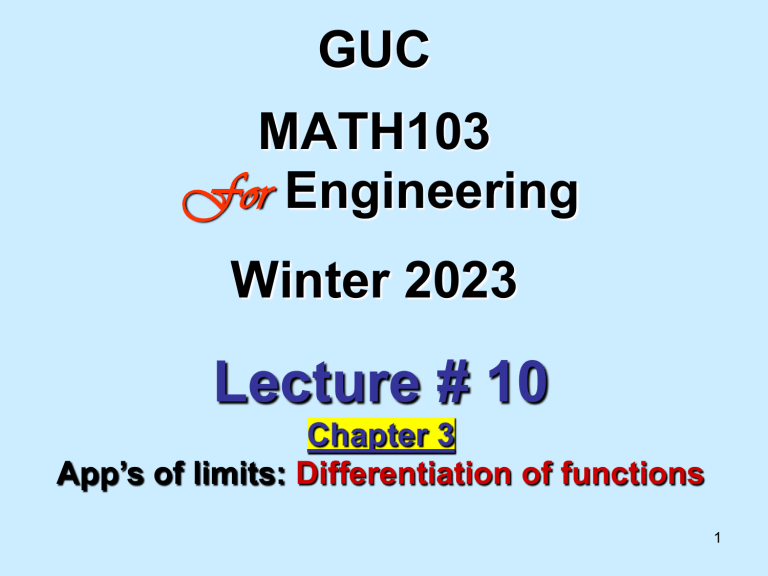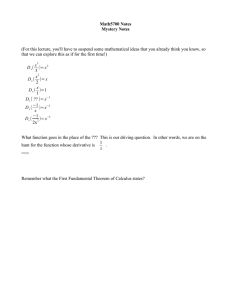
GUC MATH103 For Engineering Winter 2023 Lecture # 10 Chapter 3 App’s of limits: Differentiation of functions 1 Remark dy Find if : dx (1) y = x 2 / 3 Solution : dy 2 −1 / 3 2 1 (1) = x = .3 x 3 ( 2) y = x .e dx 3 3 x dy 3 x x 1 −2 / 3 ( 2) = x .(e ) + e .( x ) dx 3 Conclusion: For any rational number n, the derivative of x(n) is n. x(n -1). 2 Rule The proof follows from the definition Example : Find the points at which the tangent lines to the curve : y = x 4 − 2 x 2 + 2, are horizontal. Solution : y = x 4 − 2 x 2 + 2 Horizontal lines have zero slope ! y = 4 x 3 − 4 x = 4 x ( x 2 − 1) For horizontal tangent y = 0. 4 x ( x 2 − 1) = 0 x = 0, x = −1, x = 1, for x = 0 y = 2. for x = −1 y = 1. for x = 1 y = 1 the three points are (0,2), ( −1,1), (1,1). 3 1. 2. 3. 4. 5. 6. 7. 8. 9. 10. Derivative of Functions By Definition. Power function rule Square root function rule. Absolute value function rule. Product “of 2 functions” rule. Quotient “of 2 functions” rule. Exponential function rule. Logarithmic function rule. Trigonometric functions rules and their inverses. Hyperbolic functions rules and their inverses. 4 The proof follows from the definition. How? Ex : d [ x ( x 2 + 3 x − 1)] = dx = x ( x 2 + 3 x − 1)'+ ( x 2 + 3 x − 1)( x )' x ( 2 x + 3) + ( x + 3 x − 1) 2 1 2 x The proof follows from the definition. How? d 2 x2 − 1 ( x 2 + 1)( 2 x 2 − 1)'−( 2 x 2 − 1)( x 2 + 1)' Ex : [ 2 ]= dx x + 1 ( x 2 + 1)2 ( x 2 + 1)(4 x ) − ( 2 x 2 − 1)( 2 x ) 6x = = ( x 2 + 1)2 ( x 2 + 1)2 5 7- Derivative of the exponential function d x x (a ) = a . ln(a ) ?? dx ah − 1 We know that : lim = ln(a ) ? h→0 h Proof : x+h x d a − a ( a x ) = lim dx h h→ 0 = lim a x .a h − a x h = lim a x .[a h − 1] h h→ 0 h→ 0 = a x . lim h→ 0 ah − 1 = a x . ln(a ) h See problem 13 in ws4. 6 8- Derivative of the logarithmic function d 1 (ln x ) = , x 0 dx x 1 y We know that : lim(1 + y ) = e ? y →0 Proof : ln( x+h ) x h d ln( x + h) − ln x (ln x ) = lim = lim dx h h→ 0 h→ 0 h ln(1 + ) ln(1 + y ) x = By the continuity = , lim lim h x. y of “ ln(.) ” function h→ 0 y →0 (put h = y ) x 1 1 1 1 = lim . ln(1 + y ) = lim ln(1 + y ) y x y →0 y x y →0 1 y 1 1 1 = ln lim (1 + y ) = ln e = . x x x y→o Prove that d 1 (ln x ) = dx x 7 Derivative of the general logarithmic function HW. Prove it by Definition? d 1 1 (loga x ) = . dx x ln a Proof : ln x Since loga x = , ln a then, d d ln x 1 d 1 1 (loga x ) = ( )= (ln x ) = . dx dx ln a ln a dx x ln a 8 The chain rule An easier form of the theorem Example dy Find if : y = x 3 + 5 x dx 1 1 Solution : y' = ( x 3 + 5 x )' = ( 3 x 2 + 5) 2 x3 + 5 x 2 x3 + 5 x 9 Summary: special case for “x” and general case for a function “u” “chain rule” 10 Summary: special case for “x” and general case for a function “u” “chain rule” 11 7- Derivative of the exponential function HW. Prove it by Definition? d x (e ) = e x dx Can you find another function whose derivative gives the same function? Proof : Let y = e x = ln y x d d ( x) = (ln y ) dx dx 1 dy Proof by chain rule 1= y dx dy d x x = y (e ) = e dx dx 12 Derivative of the general exponential function d x (a ) = a x ln a ?? dx We know that : loga x = ln y Proof : Let y = a x = loga y = ln a d d ln y ( x) = ( ) dx dx ln a 1 dy Proof by chain rule 1= y ln a dx x dy d x = y ln a (a ) = a x ln a 13 dx dx ln x ln a Examples dy Find y' = : dx (1) y = e . ln( 2 x + 1) ( 2) y = e 3x x +2 ( x2 +7 x ) ( 3) y = (1 + x + 1 ) 10 Solutions : (1) y = e . 3x 1 2 x +1 ( 2) y = e . 2 x 1 x ( 2) + ln( 2 x + 1).e ( 3) 3x +2 ( x2 +7 x ) ( 3) y = 10(1 + x + 1 ) 9 . ln 2.( 2 x + 7 ) 1 2 x +1 14 Examples dy Find y' = for the following : dx (1) y = ln( x 2 − 6) ( 2) y = 1 + ln 2 x ln x ( 3) y = 1 + ln x (4) y = ( x 2 + 1)[ln( x 2 + 1)]2 (5) y = log 2 x + 2 x (6) y = log x +1 HomeWork Find y' for the following : y = ln( x 2 ) y = ln2 ( x ) y = ln(ln x ) 15 1 (1) y' = 2 .[2 x ] Solutions x −6 1 1 ( 2 ) y' = .[0 + 2 ln x . ] 2 x 2 1 + ln x 1 1 (1 + ln x ).[ ] − ln x .[ ] 1 x x ( 3 ) y' = = 2 (1 + ln x ) x .(1 + ln x )2 (4) y' = ( x 2 + 1).2[ln( x 2 + 1)].[ x 21+1 ][2 x ] + [ln( x 2 + 1)]2 .[2 x ] ( 5 ) y' = 1 1 1 . . x + 2 ln 2 2 x + 2 1 1 1 1 (6) y = log10 x − log10 ( x + 1) y' = . − . x ln 10 x + 1 ln 10 16 The rate of change of a function as the Derivative Given a function f (x): If x moves from “a” to “a + h”, the change in x: ∆x = (a + h) – (a) Then, the corresponding change in f (x): ∆y = f (a + h) – f (a). I - The Average Rate of Change of f (x); on [a, a + h] or for 2 points “a” & “a + h”; is defined as: f f (a + h) − f (a ) (a ) = x h II - The instantaneous rate of change of f(x) at a point “a”; is obtained when “the point Q moves to P” i.e., “as ∆x = h → 0”; is defined by: df f (a + h) − f (a ) f ( a ) = (a ) = lim dx h h→0 17 Example: If the distance( in meters) traveled by a moving object as a function of time ( in seconds) is given by: s( t ) = 2t + 3 2 Find the average velocity of the object during the first three seconds, and its instantaneous velocity in third second. Solution: s(t) = 2t2 + 3, then, x0 = 0, x0+h = 3, h = 3, hence s(x0) = s(0) = 3, s(x0+h) = s(3) = 21, s( 3) − s(0) 21 − 3 18 hence, the average velocity = 3 − 0 = 3 = 3 = 6 m / sec The instantaneous velocity as a function of time is s( t ) = 4t Therefore, the instantaneous velocity in the third second is s( 3) = 12 m / sec 18 Thank you 20



